Picture gallery
- Bank Hall Locomotive Shed on 20 June 1948: an ex-Lancashire & Yorkshire 'Pug' 0-4-0T No. 11246.
- Bank Hall Locomotive Depot in 1948: two ex-Lancashire & Yorkshire engines, 1F 0-6-0T No. 11535 and Class 30 6F 0-8-0 No. 12782.
This is a list of the locomotives of the Lancashire and Yorkshire Railway. The Lancashire and Yorkshire Railway locomotive works were originally at Miles Platting, Manchester. From 1889 they were at Horwich.
The L&YR came into being in 1847 when the Manchester and Leeds Railway changed its name. Locomotives added to its stock before that date came from the:
As the L&YR, locomotives were taken into stock from the:
Although Jenkins was the Locomotive Superintendent the early years of this period saw Hawkshaw specifying the locomotives. As Hawkshaw was not a locomotive engineer the resultant locomotives were not of the best and were hopelessly outdated long before they were withdrawn. Hurst left to join the North British Railway in 1854 and Jenkins continued on his own.
| No. of 1st built | Type | Quantity | Manufacturer | Date | Driving wheel diameter | Notes |
|---|---|---|---|---|---|---|
| 54 | 0-4-0 | 37 | Wm. Fairbairn (22) Edward Bury (15) | 1847–49 | 4 ft 9 in | Between 10 and 13 rebuilt as 0-4-2 |
| 53 | 2-2-2 | 43 | L&YR Miles Platting (26) Wm. Fairbairn (17) | 1847–49 | 5 ft 9 in | Almost all (69) rebuilt 1867-72 as 2-4-0 |
| 62 | 2-2-2 | 10 | L&YR Miles Platting (6) Wm. Fairbairn (4) | 1847–49 | 5 ft 6 in | |
| 112 | 2-2-2 | 29 | Bury, Curtis & Kennedy | 1849 | 5 ft 10 in | |
| 202 | 0-6-0 | 2 | E. B. Wilson & Co. | 1849 | 4 ft 9 in | |
| 163 | 0-4-2 | 35 | L&YR Miles Platting (26) Wm. Fairbairn (9) | 1849–70 | 4 ft 9 in | Two rebuilt in 1869 as 0-6-0 |
| 217 | 0-6-0 | 12 | L&YR Miles Platting | 1854–55 | 5 ft 0 in | |
| 141 | 0-6-0 | 149 | L&YR Miles Platting | 1855–70 | 4 ft 10 in | Between 1878 and 1887 34 were rebuilt as 0-6-0ST, 18 as 0-6-2T and 3 as 0-4-4T |
| 119 | 0-6-0ST | 11 | L&YR Miles Platting | 1855–67 | 4 ft 0 in | |
| 130 | 0-6-0ST | 26 | L&YR Miles Platting | 1856–71 | 5 ft 0 in | |
| 286 | 2-4-0 | 22 | L&YR Miles Platting | 1861–67 | 5 ft 9 in |
Following the death of Jenkins responsibility passed to Yates as Indoor Superintendent and Hurst returned as the Outdoor Superintendent. Hurst retired in 1875 and Yates resigned. A disastrous fire at the Miles Platting works in 1873 led to the building of the new Horwich Works.
The official system of numbered classes was not introduced until 1919, therefore classes are listed here according to the number of the first locomotive built.
| No. of 1st built | Type | Quantity | Manufacturer | Date | Notes |
|---|---|---|---|---|---|
| 4 | 2-4-0 | 23 | L&YR Miles Platting (23) | 1870–75 | 6 ft 0 in wheels, 16×24-in cylinders |
| 2-4-0 | 4 | ELR Bury works (4) | 1873 | ||
| 456 | 2-4-0 | 10 | LNWR Crewe | 1873 | LNWR Newton Class |
| 63 | 2-4-0 | 10 | L&YR Miles Platting | 1875–76 | 6 ft 0 in wheels, 17×24-in cylinders |
| 103 | 2-4-0 | 1 | L&YR Miles Platting | 1875 | 5 ft 6 in wheels, 16×24-in cylinders |
| 90 | 0-6-0 | 62 | L&YR Miles Platting (62) | 1869–72 | |
| 0-6-0 | 10 | Kitson & Co. (10) | 1871 | ||
| 0-6-0 | 12 | Yorkshire Engine Co. (12) | 1875 | ||
| 413 | 0-6-0 | 86 | LNWR Crewe | 1871–74 | LNWR “DX” Class |
| 23 | 2-4-0ST | 1 | L&YR Miles Platting | 1868 | |
| 32 | 2-4-0ST | 25 | L&YR Miles Platting | 1868–74 | |
| 403 | 0-4-0ST | 5 | LNWR Crewe | 1872 | |
| 216 | 0-6-0ST | 45 | L&YR Miles Platting | 1868–75 | 4 ft 0 in wheels |
| 191 | 0-6-0ST | 6 | L&YR Miles Platting | 1873–74 | 5 ft 0 in wheels |
| 161 | 0-6-0ST | 23 | L&YR Miles Platting | 1872–78 | 4 ft 6 in wheels |
Note: The class numbers below are those introduced by Hughes in 1919. Each can cover several similar varieties, e.g. all the non-superheated 0-8-0s are Class 30
During this period the Horwich Works was under construction and apart from a few built at Miles Platting, engines came from outside manufacturers.
| No. of 1st built | Type | Quantity | Manufacturer | Date | LYR Class | LMS power classification | LMS nos. | Notes |
|---|---|---|---|---|---|---|---|---|
| 605 | 0-4-2 | 8 | Sharp, Stewart & Co. | 1876 | — | — | — | GNR class F2 diverted to L&YR |
| 629 | 4-4-0 | 18 | Sharp, Stewart & Co. (18) | 1880–81 | — | — | — | |
| 4-4-0 | 30 | Neilson & Co. (30) | 1883–84 | — | — | — | ||
| 4-4-0 | 20 | Kitson & Co. (20) | 1885 | — | — | — | ||
| 4-4-0 | 20 | Vulcan Foundry (20) | 1886 | — | — | — | ||
| 209 | 4-4-0 | 16 | Vulcan Foundry | 1887 | 2 | 1P | 10100–10101 | |
| 111 | 0-4-4T | 12 | Kitson & Co. (12) | 1877–78 | — | — | — | |
| 0-4-4T | 10 | Dübs & Co. (10) | 1878 | — | — | — | ||
| 0-4-4T | 10 | Neilson & Co. (10) | 1879 | — | — | — | ||
| 0-4-4T | 40 | Sharp, Stewart & Co. (40) | 1885–86 | — | — | — | ||
| 789 | 0-4-0ST | 4 | Manning, Wardle & Co. | 1882 | — | — | — | |
| 883 | 0-4-0ST | 2 | Black, Hawthorn & Co. | 1885 | — | — | — | |
| 885 | 0-4-0ST | 1 | Kitson & Co. | 1885 | — | — | — | |
| 72 | 0-6-0ST | 8 | L&YR Miles Platting | 1877 | — | — | — | Similar to Yates "161" class but with 4 ft 0 in wheels |
| 141 | 0-6-2T | 8 | Kitson & Co. | 1880–81 | 22 | 1F | 11600–11601 | |
| 243 | 0-6-2T | 14 | Kitson & Co. (14) | 1881 | 22 | 1F | 11602–11606 | |
| 0-6-2T | 40 | Dübs & Co. (40) | 1882–83 | 22 | 1F | 11607–11621 | ||
| 528 | 0-6-0 | 57 | Kitson & Co. (57) | 1876–80 | — | — | — | All converted to Class 23 saddle tanks (below) |
| 0-6-0 | 18 | Sharp, Stewart & Co. (18) | 1877 | — | — | — | All converted to Class 23 saddle tanks (below) | |
| 0-6-0 | 40 | L&YR Miles Platting (40) | 1878–81 | — | — | — | All converted to Class 23 saddle tanks (below) | |
| 0-6-0 | 45 | Vulcan Foundry (45) | 1880–83 | — | — | — | All converted to Class 23 saddle tanks (below) | |
| 0-6-0 | 50 | Beyer, Peacock & Co. (50) | 1881–82 | — | — | — | All converted to Class 23 saddle tanks (below) | |
| 0-6-0 | 20 | Kitson & Co. (20) | 1885 | — | — | — | All converted to Class 23 saddle tanks (below) | |
| 928 | 0-6-0 | 20 | Vulcan Foundry (20) | 1887 | 25 | 2F | 12015–12034 | |
| 0-6-0 | 30 | Beyer, Peacock & Co. (30) | 1887 | 25 | 2F | 12035–12064 |
From 1889 Horwich Works was completed and from that time all engines were constructed there.
| No. of 1st built | Type | Quantity | Manufacturer | Date | LYR Class | LMS power classification | LMS nos. | Notes |
|---|---|---|---|---|---|---|---|---|
| 978 | 4-4-0 | 30 | Beyer, Peacock & Co. | 1888–89 | 2 (Aspinall) | 1P | 10102–10130 | |
| 1093 | 4-4-0 | 40 | Horwich Works | 1891–94 | 3 | 2P | 10150–10183 | 6 rebuilt with Superheater to become Class 4. One engine spent some time as a 4-cylinder compound. First 20 reused tenders from converted "568" class engines. |
| 1400 | 4-4-2 | 40 | Horwich Works | 1899–1902 | 7 | 2P | 10300–10339 | "High-Flyers." First 20 reused tenders from converted "568" class engines. |
| 1008 | 2-4-2T | 270 | Horwich Works | 1889–1901 | 5 | 2P | 10621–10869 | 26 rebuilt with Superheater to become Class 6 |
| 916 | 0-4-0ST | 3 | Vulcan Foundry | 1886 | 21 | — | 11200 | |
| 1153 | 0-4-0ST | 57 | Horwich Works | 1891–1910 | 21 | — | 11201–11257 | |
| Dot | 0-4-0WT | 8 | Beyer, Peacock & Co. (3) Horwich Works (5) | 1887-1901 | — | — | — | 18-inch gauge, for use at Horwich Works. |
| 0-6-0ST | 230 | Horwich Works | 1891–1900 | 23 | 2F | 11303–11532 | Rebuilds of "528" class tender engines | |
| 11 | 0-6-0 | 448 | Horwich Works | 1889–1918 | 27 | 3F | 12083–12467 | Many reused tenders from rebuilt "528" class engines. 63 rebuilt with Superheater to become Class 28 |
| 1351 | 0-6-0T | 20 | Horwich Works | 1897 | 24 | 2F | 11533–11546 | |
| 91 | 0-8-0 | 110 | Horwich Works | 1900–08 | 30 | 5F | 12700–12759 | Small boiler, 50 later rebuilt (see below) |
| No. of 1st built | Type | Quantity | Manufacturer | Date | LYR Class | LMS power classification | LMS nos. | Notes |
|---|---|---|---|---|---|---|---|---|
| 202 | 2-6-2T | 20 | Horwich Works | 1903–04 | 26 | 3F | 11700–11716 | |
| 392 | 0-8-0 | 21 | 1903 | 30 | First was experimental rebuild of "91" class, rest new, all with corrugated cylindrical steel firebox. All rebuilt by Hughes (below). |
| No. of 1st built | Type | Quantity | Manufacturer | Date | LYR Class | LMS power classification | LMS nos. | Notes |
|---|---|---|---|---|---|---|---|---|
| 4-4-0 | 6 | 1908–09 | 4 | 3P | 10190–10195 | Superheated. Rebuilds of Class 3 | ||
| 1506 | 4-6-0 | 20 | Horwich Works | 1908–09 | 8 | 3P | 10400–10404 | [1] 4-Cylinder, 15 rebuilt with superheaters (see below) |
| 1522 | 4-6-0 | 70 | Horwich Works | 1920–24 | 8 | 5P | 10405–10474 | [2] Superheated, 15 were rebuilds. |
| 1 | 0-2-2T | 2 | Kerr, Stuart & Co. | 1905 | — | — | — | [3] Railmotor locos. Withdrawn 1909 and replaced by following class. |
| 3 | 0-4-0T | 18 | Horwich & Newton Heath Works | 1906–11 | 1 | — | 10600–10617 | [4] Railmotor locos |
| 816 | 2-4-2T | 40 | Horwich Works | 1905–10 | 5 | 2P | 10870–10899 | [5] Belpaire firebox, 18 later superheated to become Class 6 |
| 18 | 2-4-2T | 64 | Horwich Works | 1911 | 6 | 3P | 10900–10954 | [6] Belpaire & Superheated, 44 were rebuilds of Class 5 |
| 1501 | 0-8-2T | 5 | Horwich Works | 1908 | 32 | 6F | 11800–11804 | [7] |
| 898 | 0-6-0 | 22 | Horwich Works | 1906–09 | 28 | 3F | 12515–12536 | [8] Superheated |
| 657 | 0-6-0 | 20 | Horwich Works | 1912 | 28 | 3F | 12537–12556 | [9] Belpaire & Superheated |
| 0-6-0 | 63 | 1913–22 | 28 | 4F | 12557–12619 | Belpaire & Superheated, rebuilds of Class 27 | ||
| 1452 | 0-8-0 | 11 | Horwich Works | 1906–07 | 30 (Hughes compound) | 5F | 12760–12770 | [10] 4-cylinder compound; first was rebuilt, rest new |
| 9 | 0-8-0 | 73 | Horwich Works | 1910–18 | 30 (Hughes) | 6F | 12771–12839 | [11] Large saturated boiler, with Belpaire firebox. 33 were rebuilds, 40 new. 4 later rebuilt with superheaters as Class 31. |
| 1546 | 0-8-0 | 15 | Horwich Works | 1912–21 | 31 | 7F | 12840–12994 | [12] Superheated Belpaire boiler. 115 were new builds, others were rebuilds of Class 30 0-8-0s. |
| 2-10-0 | not built | 1914 | 2-10-0 | A design for a heavy mineral loco, not constructed owing to the outbreak of war. | ||||
| (1684) | 4-6-4T | 10 | Horwich Works | 1924 | (none) | 5P | 11110–11119 | [13] Superheated. L&YR design introduced after grouping. Twenty more were ordered but were constructed as Class 8 4-6-0. [14] |
| 1629 | 2-8-0 | 27 | Kitson & Co. (1) R. Stephenson & Co. (5) Nasmyth, Wilson & Co. (2) North British Loco. Co. (19) | 1919 | — | — | — | [15] Robinson ROD 2-8-0 type. Hired from the government in November 1919, but transferred to GWR and LNWR March–June 1920. No L&YR numbers allocated |
| 1 | 1-AA-1 | 1 | Horwich Works | 1912 | — | — | — | [16] Electric locomotive |
| 2 | B | 1 | Horwich Works | 1917 | — | — | — | [15] Battery-Electric |
The "number only" classes are those introduced by George Hughes in 1919 and shown in the L&YR working timetable appendix of 1921. [17] There is also a series of unofficial "letter and number" classes which was devised by the author R. W. Rush, and which has been copied by some other authors. [18]
Seven locomotives survive, these being:
| Image | Class | Type | L&Y No. | LMS No. | BR No. | Manufacturer | Serial Number | Date | Notes |
|---|---|---|---|---|---|---|---|---|---|
 | 23 | 0-6-0ST | 752 | 11456 | — | Beyer, Peacock & Co. | 1989 | 1881 | Rebuilt as saddle tank in 1896; sold to coal industry 1937; owned by Lancashire and Yorkshire Railway Trust, restored to steam in public service at the East Lancashire Railway at Bury in early 2020. |
 | Dot | 0-4-0ST | Wren | Wren | Wren | Beyer, Peacock & Co. | 2825 | 1887 | 18-inch gauge Horwich Works shunter; static display, National Railway Museum, York |
 | 25 | 0-6-0 | 957 | 12044 | 52044 | Beyer, Peacock & Co. | 2840 | 1887 | Owned by 957 Bowers Trust, awaiting overhaul, last used on Keighley and Worth Valley Railway in January 2013 but in 2021 restored to steam initially in green as the 'Green Dragon' as used in 1970 Railway Children film, now running as 52044 in BR goods black livery. |
 | 5 | 2-4-2T | 1008 | 10621 | 50621 | Horwich Works | 1 | 1889 | Static display, National Railway Museum, York |
 | 27 | 0-6-0 | 1300 | 12322 | 52322 | Horwich Works | 420 | 1895 | In regular use on preserved railways since 2009 |
 | 21 | 0-4-0ST | 68 | 11218 | 51218 | Horwich Works | 811 | 1901 | First preserved loco to arrive at Keighley and Worth Valley Railway in 1965, owned by Lancashire and Yorkshire Railway Trust, awaiting restoration at Keighley and Worth Valley Railway. |
 | 21 | 0-4-0ST | 19 | 11243 | — | Horwich Works | 1097 | 1910 | Sold by LMS to private industry, now owned by Lancashire and Yorkshire Railway Trust, on display at Ribble Steam Railway for many years, in early 2020 relocated to the East Lancashire Railway at Bury and restoration to steam completed there in 2022. |

The Lancashire and Yorkshire Railway (L&YR) was a major British railway company before the 1923 Grouping. It was incorporated in 1847 from an amalgamation of several existing railways. It was the third-largest railway system based in northern England.
George Hughes was an English locomotive engineer, and chief mechanical engineer (CME) of the Lancashire and Yorkshire Railway (L&YR) and the London, Midland and Scottish Railway (LMS).
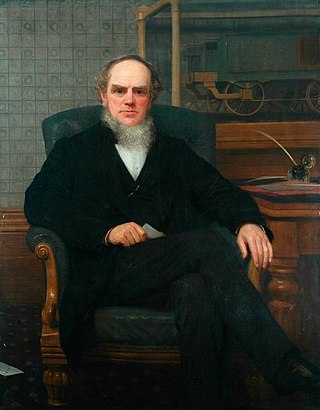
John Ramsbottom was an English mechanical engineer. Born in Todmorden, then on the county border of Yorkshire and Lancashire. He was the Chief Mechanical Engineer for the London and North Western Railway for 14 years. He created many inventions for railways but his main legacy is the split metal piston ring, virtually all reciprocating engines continue to use these today.

Richard Edward Lloyd Maunsell held the post of chief mechanical engineer (CME) of the South Eastern and Chatham Railway from 1913 until the 1923 Grouping and then the post of CME of the Southern Railway in England until 1937. He had previously worked his way up through positions in other railways in Ireland, England and India.
The East Lancashire Railway operated from 1844 to 1859 in the historic county of Lancashire, England. It began as a railway from Clifton via Bury to Rawtenstall, and during its short life grew into a complex network of lines connecting towns and cities including Liverpool, Manchester, Salford, Preston, Burnley and Blackburn.
The North Union Railway was an early British railway company, operating two main routes, from Parkside to Preston and from Bolton Trinity Street to Preston, all in Lancashire. The northerly part of the routes sharing the line from Euxton to Preston.
Locomotives of the London and North Western Railway. The London and North Western Railway (LNWR) Locomotive Department was headquartered at Crewe from 1862. The Crewe Works had been built in 1840–43 by the Grand Junction Railway (GJR).
William Barton Wright was an English mechanical engineer, also tea plantation owner and mine owner. He was Locomotive Superintendent of the Lancashire and Yorkshire Railway (LYR) from 1875. During his ten-year career in that post he helped to make the LYR one of the most efficient railways in the United Kingdom, by designing a range of good locomotives to haul the LYR's traffic.

Horwich Works was a railway works built in 1886 by the Lancashire and Yorkshire Railway (LYR) in Horwich, near Bolton, in North West England when the company moved from its original works at Miles Platting, Manchester.
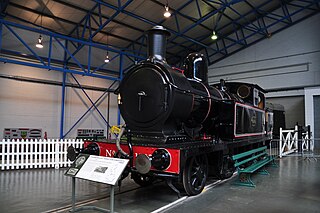
The Lancashire and Yorkshire Railway Class 5 were 2-4-2T steam locomotives designed by Chief Mechanical Engineer (CME) John Aspinall and introduced from 1889 for local passenger work. Later batches included progressive modifications such as extended coal bunkers and Belpaire fireboxes. The final batch built from 1911 to 1914 under George Hughes incorporating superheated boilers gave increased tractive effort, others were also rebuilt to this standard. When Hughes introduced his classification system in 1919, the more powerful superheated locomotives were designated Class 6. The final examples were withdrawn in 1961.
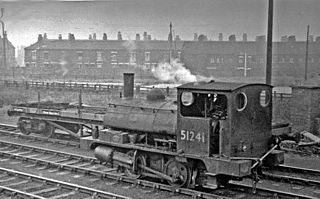
The L&YR Class 21 is a class of small 0-4-0ST steam locomotive built by the Lancashire and Yorkshire Railway for shunting duties. They were nicknamed Pugs.

The Lancashire and Yorkshire Railway Class 27 is a class of 0-6-0 steam locomotive designed for freight work on the Lancashire and Yorkshire Railway (L&YR).

The Lancashire and Yorkshire Railway (L&YR) Class 23 is a class of 0-6-0ST steam locomotive. Their main use was for shunting and for short-trip freight working.
Longton Bridge was a railway station on the West Lancashire Railway in England. It served the village of Longton.
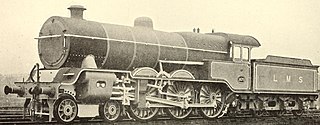
The Lancashire and Yorkshire Railway (L&YR) Class 8 was a four-cylinder 4-6-0 express passenger locomotive designed by George Hughes introduced in 1908.
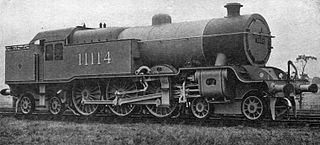
The Lancashire and Yorkshire RailwayHughes 4-6-4T was a class of steam locomotives. They were a 4-6-4T tank engine version of the L&YR Class 8, hence they were known as "Dreadnought tanks".
The Lancashire and Yorkshire Railway (L&YR) operated two classes of twenty steam railmotors in total.

The L&YR Class 24 was a class of short-wheelbase 0-6-0T steam locomotives of the Lancashire and Yorkshire Railway (L&YR). It was designed by Aspinall and introduced in 1897 for shunting duties. Twenty locomotives were built, but six were withdrawn between 1917 and 1922.
The Bolton and Preston Railway (B&PR) connected Bolton and Preston, in Lancashire, England. Its authorising Act of Parliament forbade its early completion to protect the North Union Railway (NUR) and imposed other restrictions that limited the success of the B&PR. A change of route was authorised to bypass the delay making it dependent on the goodwill of the NUR to reach Preston. The NUR saw the B&PR as a competitor and used underhand tactics to harm the success of the B&PR.

The LNWR Newton Class was a class of ninety-six 2-4-0 steam locomotives built by the London and North Western Railway at their Crewe Works between 1866 and 1873.